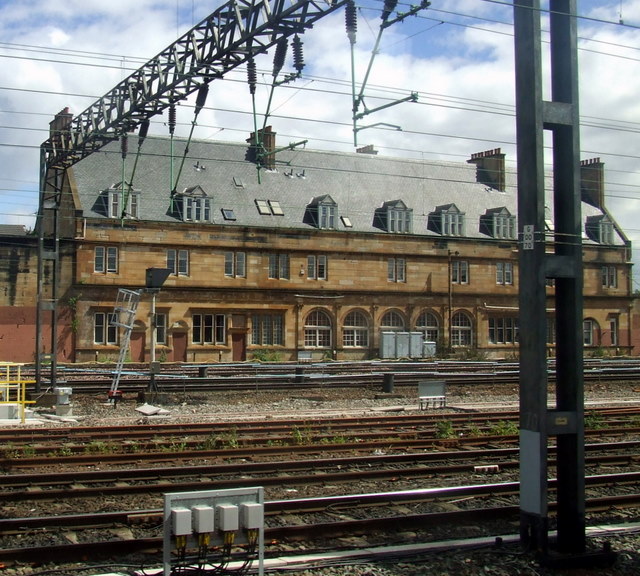- Glasgow Bridge Street railway station
Infobox UK disused station
name = Bridge Street
other_name=

caption =
line =Glasgow and Paisley Joint Railway
manager = Caledonian and Glasgow & South Western Railways
locale =Glasgow
borough =Lanarkshire
latitude = 55.8533
longitude = -4.2596
years =31 August 1840
events = Opened as terminal station: south side Clyde coast services
years1 = 1879
events1 = Rebuilt to provide two through platforms to Glasgow Central Station and 4 bay platforms
years2 = 1883
events2 = G&SWR Clyde services diverted to St Enoch station
years3 = 1905
events3 = Closed, platforms removed. Site of bay platforms used as carriage sidings for Central station
platforms = Originally: 2 bay
Later: 2 through and 4 bay
: "For theGlasgow subway station of the same name seeBridge Street subway station .Glasgow Bridge Street railway station was a railway station and the originalGlasgow terminus of theGlasgow and Paisley Joint Railway ; jointly owned by theGlasgow, Paisley and Greenock Railway (GP&G), which later merged with theCaledonian Railway , and theGlasgow, Paisley, Kilmarnock and Ayr Railway (GPK&A), which became part of theGlasgow and South Western Railway .Paton, John (2006). "Design Worthy of the City". Chapter 4, In: Cameron (2006).]The station opened for traffic on the GPK&A in August 1840; and for traffic on the GP&G in March 1841. It was sited on the south side of the
River Clyde , but was close to the centre ofGlasgow .Clyde services terminus station
The opening of the Glasgow, Paisley and Greenock railway took away a lot of the river traffic from Glasgow; instead the steam boats terminated at
Greenock and the railway was used between Greenock and Glasgow. The railway journey was 1 hour against 2.5 to 3.5 hours for river traffic. Similarly the Glasgow, Paisley, Kilmarnock and Ayr Railway provided a quicker journey to the coast than the river journey.Thomas, John (1971). Chapter VII - "The River Clyde and Loch Lomand".]Some 21,890 people used the service during Glasgow Fair week in July 1841.
It remained the Clyde services terminus of both the Caledonian Railway and the Glasgow and South Western Railway for nearly thirty years. Both railway companies wanted to cross the Clyde but were precluded from doing so by Glasgow Corporation, the Clyde Navigation Trustees, the Bridge Trustees; and finally by the
Admiralty , who insisted on bridges with at least one lifting section.The Caledonian Railway's main line from
London , via Carstairs, which opened to Edinburgh on15 February 1848 and to Glasgow on1 November 1849 remained on the north-side of the Clyde, atBuchanan Street , eventually moving to Glasgow Central Station (see below).Diversion of G&SWR services
The
Glasgow and South Western Railway (G&SWR) achieved the first river crossing, by means of the City of Glasgow Union Railway. The line left the Joint Railway near Shields Road (nowShields Junction ) and continued through theGorbals . It crossed the River Clyde at Hutchesontown to their newSt Enoch railway station . The line and station opened on1 May 1876 ; construction of the line having taken 11 years.MacIntosh, Jim. (2006). "Glasgow and the Caledonian Railway". Chapter 2, In: Cameron (2006).]In 1883, St Enoch railway station became the headquarters of the Glasgow and South Western Railway, and all services were diverted to St Enoch.
Refurbishment by the Caledonian Railway
The Caledonian Railway eventually built their new terminal station, Glasgow Central station, which opened in 1879 on the north-side of the River Clyde. Access to Glasgow Central station was gained via a four-track railway bridge, built by
Sir William Arrol parallel to Glasgow Bridge. Central station initially had eight platforms.Bridge Street station was also refurbished in 1879. Two new through platforms provided access to Glasgow Central station. Bridge Street however remained the terminus, for the time being, for the
Glasgow, Paisley and Greenock Railway ; which had two dedicated bay platforms. Another two bay platforms were for G&SWR use.Closure as a terminus
Between 1901 and 1905 Glasgow Central Station was refurbished and extended over the top of Argyle Street; and thirteen platforms were built. An additional eight-track bridge was built over the
River Clyde ; and the original four-track bridge was raised by 30 inch (0.76 m). Bridge Street station then closed as a terminal station and the platforms were removed. The area previously occupied by the four bay platforms was used as carriage sidings for Glasgow Central Station; and the area previously occupied by the through platforms was used as running lines to Central Station. The remaining Caledonian Railway Clyde Coast services were extended to Glasgow Central Station and the remaining G&SWR services diverted to St Enoch station. A new signalling scheme for Glasgow Central in the 1900s led to the construction of a new power operatedsignal box . It was cantilevered off the eight-track bridge; sitting suspended between the two river bridges.Nelson, Robin (2006). "Signal box with a view". Chapter 17 In: Cameron (2006).] Signal installation commenced in October 1907; the west side was commissioned on5 April 1908 and the remainder on3 May 1908 .References
Notes
ources
* Cameron, Dugald (Compiler) (2006). "Glasgow Central: Central to Glasgow". Boat of Garten: Strathwood Ltd. ISBN 1-905276-05-2.
*
* Nock O.S., (1963). "The Caledonian Railway". London: Ian Allan Ltd.
*
*
*###@@@KEYEND@@@###
Wikimedia Foundation. 2010.
